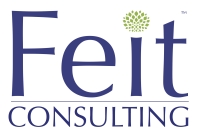
Collection Re-balancing: Facilitating the Move from Print to Digital in Law Firm Libraries and Information Services
By Becky Bowman and Stuart Zimmerman | Feit Consulting
In part I of this 2-part report, we looked at the drive to enhance digitization and provided some top reasons, challenges and paths to success.
What to cut? How to decide?
The determination of which print resources are ripe for online replacement begins with an examination of current print spend by vendor in tandem with a review of online holdings. A tracking spreadsheet [sample below] is a useful tool for this process.
Sample tracking spreadsheet

Most firms will find that the bulk of their print spend is with some combination of the big four vendors; Thomson Reuters, Lexis, Bloomberg and Wolters Kluwer. Each of these vendors offers robust online services that include the majority of their print publications.
Using Resource Types [see box below] as a rough guide, calculate and plot the cancellation potential (high or low) of each title on the spreadsheet which, when sorted, will surface those titles with high potential for cancellation. Continue working down the list of print by vendor, reviewing online options and plotting cancellation potential. Not every print resource has a digital equivalent.

Licensing terms can vary greatly from vendor to vendor. Make sure that contracts/licenses are adequate to cover all who need access to each resource. Identify gaps in online content and/or any material contract limitations and see if there is a need to expand current contracts or purchase additional licenses.
Once the list of titles with high cancellation potential has been generated and the online alternatives identified and vetted the emphasis moves to a communication campaign to reach users who will be impacted by the elimination of those print resources with high cancellation potential.
Many users will be fine with the move to online and some will express concerns. Listen carefully while making final determinations. This is an excellent time to learn how resources are being used, and the value these resources bring to the firm, directly from the end-users themselves.

Reality Checks
- The process of reducing print involves series of compromises and occasional hard decisions to navigate sometimes-competing goals. Be flexible and pick your battles.
- Not everything needed is available online and just because something is available online doesn’t mean that it is accessible. Costs, inflexible licensing terms, and incompatible technologies can thwart the best plans.
- It is not uncommon for firms to increase spending on digital media in order to realize print-cutting goals. Review budget impacts of needed contract changes, additional licenses, etc.
- When needed publications are not available in digital/online formats, options are fairly limited; purchase and maintain print or rely on third-party sources.
- Firms will need the flexibility to accommodate some print to achieve maximum efficiency.
Conclusion
While there will never be a completely paper-free library, law firms are realizing good success in rebalancing their collections and actively managing the usage of online and digital resources while reducing their reliance on print to best fit their specific goals.
Feit Consulting offers Contemporary Library Solutions, reviewing law library operations and assessing collections to identify opportunities to improve utilization of information resources, maximize efficiencies and improve ROI.
Contact Feit Consulting today to set up a free consultation

About the Author
Becky Bowman, Law Library Consultant Becky served as the Chief Research and Information Analysis Officer for Am Law 100 firm, Baker Donelson for 32 years where she ultimately led a team of 5 to serve 750+ attorneys across 23 domestic locations. Becky’s accomplishments at Baker were multiple, including transforming the library from print to digital, overseeing the efficient combination of 15 mergers and acquisitions of library materials, and successfully rebranding her department, and achieving buy-in from key stakeholders. Her exceptional experience is invaluable for clients as they assess the actual total cost and value of their library and research department including current print and digital collections, vendor contracts, as well as consider cultural and workflow disruptions or benefits in moving to an outsourcing vendor.

About the Author
Stuart Zimmerman, Law Library ConsultantStuart provides strategic input on library and research services in large law firms with a focus on library audits, the development of best practices for the delivery of library services, and the implementation of new generations of digital resources for research and library administration. Stuart brings more than 25 years of law library experience both in law firms and public law libraries. Prior to joining Feit Consulting, Stuart was Director of Research and Information Services for Davis Wright Tremaine LLP where he transformed a patchwork of individual law office libraries into a coordinated, efficient, contemporary, firm-wide library system providing high-quality research and library services across nine offices.






